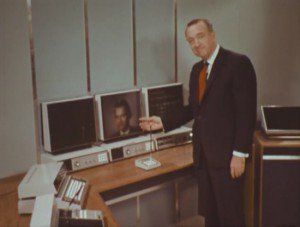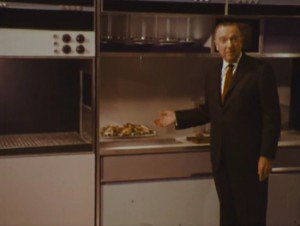By Geneva Ives on March 12, 2013 in Technology

Editors’ note: Geneva Ives is the marketing writer for Point2, a leading provider of online marketing solutions for real estate professionals, including custom websites, syndication tools and prospecting utilities. She will be contributing technology-oriented real estate interest posts to The Balance Sheet.
It’s no secret that the team at Point2 is a little home obsessed. We’ve been providing real estate marketing services for over a decade now; it’s fair to say we’ve seen a lot of properties (and housing trends) in that time.
We recently encountered this house-centric blog post on Smithsonian.com that features video clips from the long-canceled CBS weekly documentary program entitled “The 21st Century.” The episode in question originally premiered on March 12, 1967. In it our host, legendary news anchor Walter Cronkite, escorts us around a vision of the single family home in the year 2001. Modern marvels abound – inflatable furniture, multicolored plastics, illuminated speakers. It’s a wonderland inspired by rapid advances in technology.
That got us thinking: holy moly, the future is now! Decades past had such high aspirations for the year 2000 and beyond. Are we living up to the hype?
To address this question, we decided to take a look at three specific rooms in the homes of today. How do they compare to their counterparts in homes of the 1960s? And how do they compare and contrast with the futuristic visions previewed by Mr. Cronkite?
The Kitchen
1960s Trends: According to back issues of House Beautiful, contemporary eat-in kitchens celebrated saturated colors and wood cabinetry.

21st Century Predictions: The CBS writers of the day posited that we would enjoy irradiated foods, automated meal preparation and dishes that are molded on the spot in the 21st century. Clean up would be a snap. Dirty plates, complete with leftovers, would be melted down at the end of the day.
Actuality: While robot chefs and melting dishware aren’t reality yet, we can always hope. Irradiated food – a process in which food is dosed with radiation for a variety of reasons, including to slow decay – was already being tested in the US at the time of initial broadcast and became widespread in the 1980s. You might not realize it, but many items you buy at the grocery store today may be irradiated. What modern kitchen convenience can we claim that wasn’t featured in this video? A refrigerator that dispenses chilled soda water. The cocktail culture of the 1960s would have been jealous.
The Living Room
1960s Trends: Horizontal lines, wood paneling and easy-care aka synthetic fabrics welcomed modern families throughout that decade.
21st Century Predictions: Cronkite’s 2001 living room, conceived by Philco-Ford and designed byPaul McCobb, boasted a big screen 3D television, globe-like speakers that fill the room with stereophonic sound and a credenza-sized control center to operate it all.
Actuality: Although 3D TVs weren’t readily available in 2001, you can now buy them for around $500. And fortunately, today’s control panel doesn’t require nearly as much space; your entire entertainment system can be controlled from your tablet or smartphone. But the video did make us wonder: has anyone made those drool-worthy spherical speakers yet? A quick internet search turned up only one with a similar look: the Grundig Audiorama 9000, a round speaker with a cult-following that can be suspended from the ceiling and was introduced in (wait for it) the 1970s. Recently updated and re-released, these speakers, unfortunately, do not light up.
The Home Office
1960s Trends: Um… maybe desks? Home offices were in their infancy back then, with more emphasis placed on dens and studies.
21st Century Predictions: Normal business activities will be carried out without needing to leave your house. Three different screens will allow you to check the weather, video-conference and watch home surveillance cameras. The news is delivered via satellite to a monitor with a large format printer.
Actuality: The home offices of 2013 are light years ahead of even the loftiest visions for 2001. We can do all of the above and then some using a single computer or, even more remarkable, the phone in our pocket. According to The State of Telework in the U.S., a report from October of 2012, an estimated 3.1 million employees work from home, and that number is growing. Our home offices are rapidly becoming our primary offices.
When “The 21st Century” first aired, the house of 2001 probably seemed farfetched to viewers. In retrospect, we have realized and even surpassed many of their seemingly optimistic forecasts. So we’re ready to start looking ahead and set our sights on, say, 2050. What do you hope the future holds for the homes of the future? Maybe a little something like this? We’ll watch the real estate listings for you!


